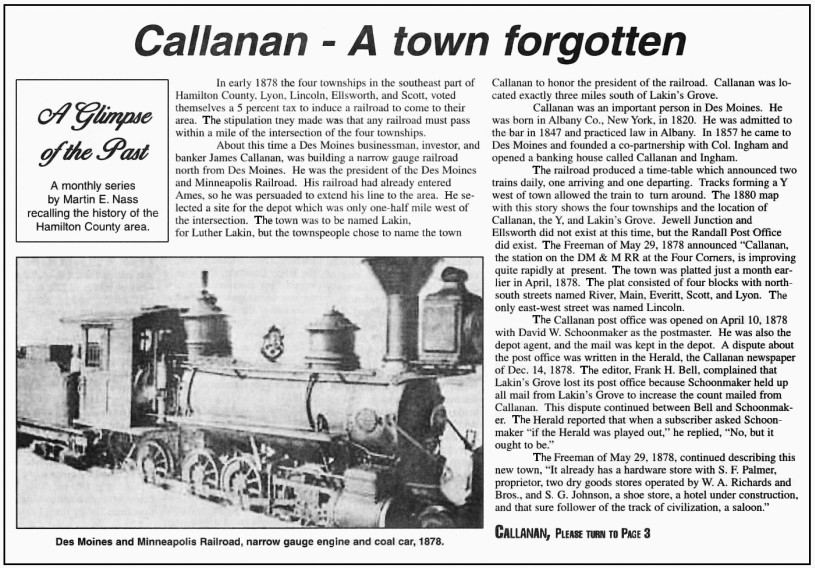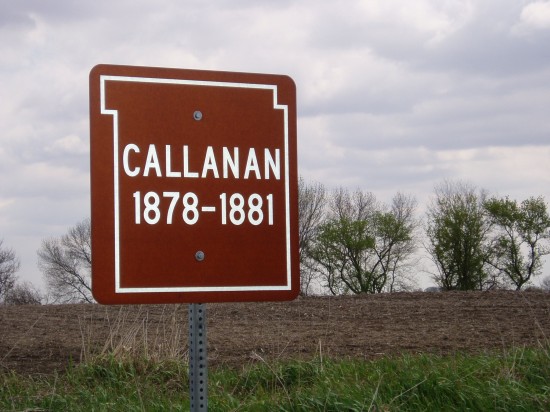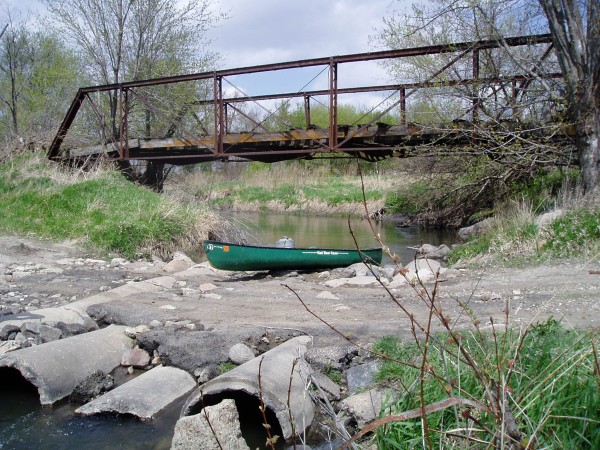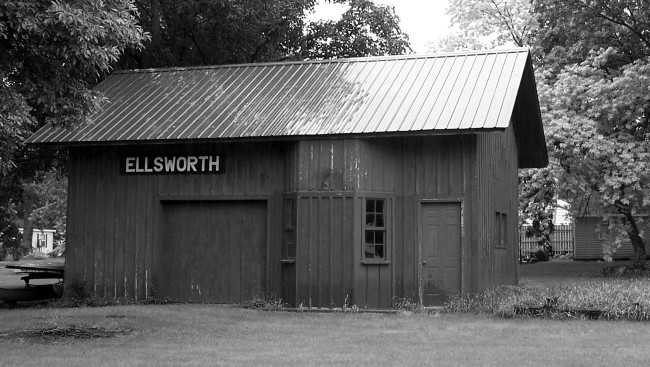
(click to enlarge image)
Notice this locomotive is labelled "James Callanan".
Des Moines & Minnesota No. 3, an ungainly Danforth 2-6-0 of 1875, bore
the name of the railroad's president, James Callanan.
(image from the Thomas T. Taber collection, Railroad Museum of Pennsylvania)
In addition to his business
interests, Callanan was interested in education. He was a liberal
giver to The Home for the Aged, Penn College in Oskaloosa,
and was president of the Iowa Humane Society. He donated
land to Mercy Hospital which was later sold to the Des Moines Schools.
Callanan Junior High was named for him. It is now called Callanan
Middle School. He also founded a normal College, then Callanan Normal
College. After a fire destroyed part of the building, the college
was moved to Drake University, to which he was also a donor.
Eventually, Callanan Normal College became the College of Education of
Drake. James Callanan also was important for his donations
for the start of Iowa Methodist Hospital. Mr. Callanan died
in Des Moines in 1904. Read news
articles about James Callanan, the man whose name was used for the
first platted town in southeast Hamilton County. |
| |

(This news article may be enlarged with a click - it
is also written below:)
Callanan - A Town Forgotten
In early 1878, the four townships
in the southeast part of Hamilton County, Lyon, Lincoln, Ellsworth and
Scott, voted themselves a 5% tax to induce a railroad to come to their
area. The stipulation they made was that any railroad must pass within
a mile of the intersection of the four townships.
About this time, a Des Moines
businessman, investor, and banker James Callanan, was building a narrow
gauge railroad north from Des Moines. He was the president of the
Des Moines and Minneapolis Railroad. His railroad had already entered
Ames, so he was persuaded to extend his line to the area. He selected
a site for the depot which was only one-half mile west of the intersection.
The town was to be named Lakin, for Luther Lakin, but the townspeople chose
to name the town Callanan to honor the president of the railroad. Callanan
was located exactly three miles south of Lakin's Grove.
James Callanan was an important
person in Des Moines. He was born in Albany Co., New York, in 1820.
He was admitted to the bar in 1847 and practiced law in Albany.
In 1857 he came to Des Moines and founded a co-partnership with Col. Ingham
and opened a banking house called Callanan and Ingham.
The railroad produced a time-table
which announced two trains daily, one arriving and one departing from Callanan.
Tracks forming a Y west of town (atop the hill on the west side of the
Skunk River) allowed the train to turn around. The 1880 map with
shows the four townships and the location of Callanan, the Y, and Lakins'
Grove. Jewell Junction and Ellsworth did not exist at this
time, but the Randall Post Office did exist. The "Freeman"
of May 29, 1878 announced Callanan, the station on the DM & M RR at
the Four Corners, is improving quite rapidly at present. The town
had been platted just a month earlier in April, 1878. The plat consisted
of four blocks with north-south streets named River, Main, Everitt, Scott,
and Lyon. The only east-west street was named Lincoln.
The Callanan post office was opened on April 10, 1878
with David W. Schoonmaker as the postmaster. He was also the
depot agent, and the mail was kept in the depot. A dispute
about the post office was written in the "Herald", the Callanan
newspaper of Dec. 14, 1878. The editor, Frank H. Bell, complained
that Lakin's Grove lost its post office because Schoonmaker held up all
mail from Lakin's Grove to increase the count mailed from Callanan.
This dispute continued between Bell and Schoonmaker. The Herald reported
that when a subscriber asked Schoonmaker if the Herald was played out.
He replied, "No, but it ought to be."
The "Freeman" of May 29, 1878, continued describing
this new town, "It already has a hardware store with S. J Palmer, proprietor,
two dry goods stores operated by W. A. Richards and Bros., and S. G. Johnson,
a shoe store, a hotel under construction, and that sure follower of the
track of civilization, a saloon."
|

If you cannot read this sign, click on the image to see a clearer
version.
|

(enlarge with a click - or read below:)
It also reported that 16 carloads
of grain and stock were shipped from Callanan, and five carloads of merchansdise
were shipped in during one week. The trains came north on the west
side of the Skunk River, then crossed the river, and ran up a slope to
the town. Sometimes the engineer did not have enough speed, and the
loaded train could not make the grade. Then the engineer backed down
a long way and made another run at higher speed.
At its highest point, Callanan
numbered about 200 people. The business register showed two surgeons,
several contractors, a hotel, a boarding house, three painters, a hardware
store, a drug store, two dry goods stores, a pool hall, a barber shop,
a brickyard, a blacksmith shop, a carriage and wagon shop, and a meat market.
Charles Lakin was the town barber. He ran the pool hall in
the same location and also sold coal, hair, lime, and farm machinery.
On June 26, 1878, "Freeman"
reported on the planned celebration of a "Regular Seventy-Six time in this
little city of the 4th of July." The "Freeman" turned
out the flyers which announced "the program of the occasion - wich will
be made up of cannon firing at daybreak, orations by speakers from abroad,
balloon ascension at 3 in the afternoon, and a display of fire works in
the evening. A Des Moines brass band will furnish the music.
A basket dinner, toasts, responese, ball playing, foot racing, callathumpian
displays, concluding with dancing in the evening."
This same paper announced
that Callanan had erected fully a dozen buildings and has cellars and foundations
laid for a hotel and three more residences. The article ended with
the editor stating, "Callanan will be one of the most important little
towns in the county."
The little narrow gauge line
was the means of bringing many excursion parties from Ames and Des Moines
for a weekend of partying and drinking in the beautiful wooded area.
Every mention of the town gives an indication that liquor flowed freely
at all times, and when some sober citizens expressed concern for the future
of their town, the residents were quickly told that this was good for business
and the future prosperity of the town. This atmosphere contributed
to two murders being committed during the very short life of the town.
A shooting ws reported in
the "Freemen" on July 8, 1879. The shooting took place at
the 4th of July celebrations. As the train was pulling out of the
depot, John Anderson thrust his hand out of the car window and fired two
shots into the crowd on the platform. Both balls struck Jacob Hank,
who was standing in the crowd, one hitting him in the groin and the other
in his leg. Justice Black, of Callanan, conducted a hearing, and
Anderson was held on bond of $2,000 for the Grand Jury. The general
belief was that Anderson had been drinking freely during the day, drew
his revolver and dired it without stopping to see where it was pointed.
The Des Moines
& Minneapolis Railroad when into bankruptcy, and all effors to
continue the line north ceased. The Toledo and North Western Railroad
took over the bankrupt line and on May 28, 1879 it was reported that C.
C. Whitten, Esq., of Toledo, Iowa was in Webster city. He was
the right-of-way agent of the Toledo & North Western.
He reported that everything was favorable for an extension of the line
to Webster City. By May of 1880, the line was opened to Ellsworth
and Jewell Junction. The narrow gauge track was replaced with standard
gauge track for the entire way. (Tracks for the narrow gauge were
set 3 foot apart and was a cheaper way to lay out a railroad.) The
engine and cars were smaller. Standard gauge had tracks that were
4 foot, 8 and one-half inches wide. It was later learned that
the Toledo & North Western Railroad was really a front for the
Chicago
& Northwestern Railroad. This line bypassed Callanan, which
rapidly declined in importance. Most of the residents moved to Ellsworth
or Jewell Junction. The town of Kamrar was laid out and the train
came into Webster City of December 6, 1880.
In addition to
his business interests, James Callanan was interested in education.
He was a liberal giver to The Home for the Aged, Penn College
in Oskaloosa, and was president of the Iowa Humane Society.
He donated land to Methodist Hospital, which was later sold to the
Des Moines Schools. Callanan Junior High was named for
him. It is now called Callanan Middle School.
He also founded a normal college where teachers were trained. It
was first called Callanan College, then Callanan Normal College.
After a fire detroyed part of the building, the collge was moved to Drake
University, to which he was also a donor. Eventually, the Callanan
Normal College became the College of Education of Drake.
Mr. James Callanan died in Des Moines in 1904.
(This was printed in the Freeman Journal and the text is
no longer found at this address:
http://showcase.netins.net/web/marjned/callanan.html)
|
Envelope of a letter posted from Callanan on June 25,
1880


The settlement of Callanan was located near today's
intersection of Tollman Avenue and 340th Street.
Today, two signs mark that corner where Callanan once
existed. Directly North across the 340th is where North Callanan
would have been.

Today, the Skunk River in the Callanan area has a bridge
across the Skunk River. However, this Skunk River bridge was not
the railroad bridge crossing the river so that trains could go up the hill,
cross Tollman Avenue, and be at the Callanan depot.
The grade up the hill was steep enough
that as the train crossed the river to approach Callanan, the engineer
needed to head around the turn and go up the hill at full throttle.
If the attempt was not successful, the train wuld have to back down and
make another run.


The Ellsworth depot is not the only surviving relic
of Callanan.
Read the next page to find why more Callanan materials
still survive today.
Next Callanan Page (4)
Back Home
|

